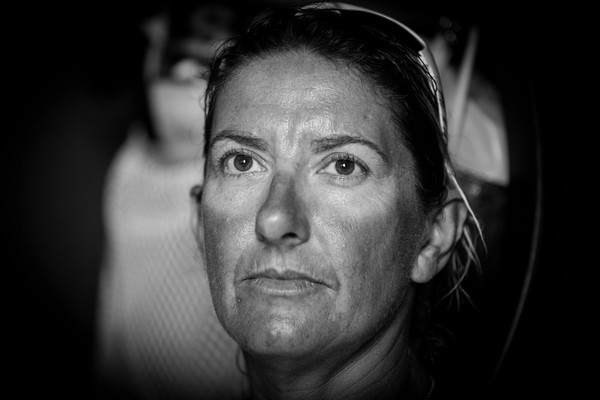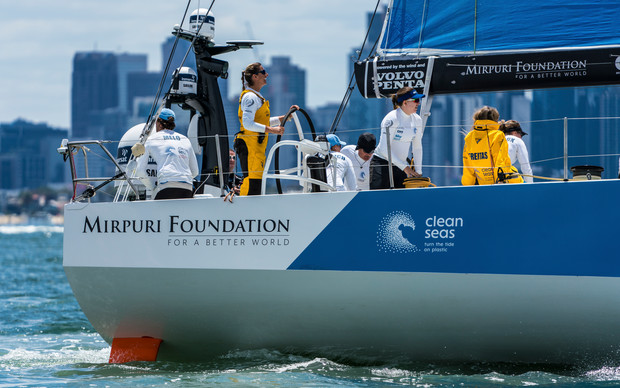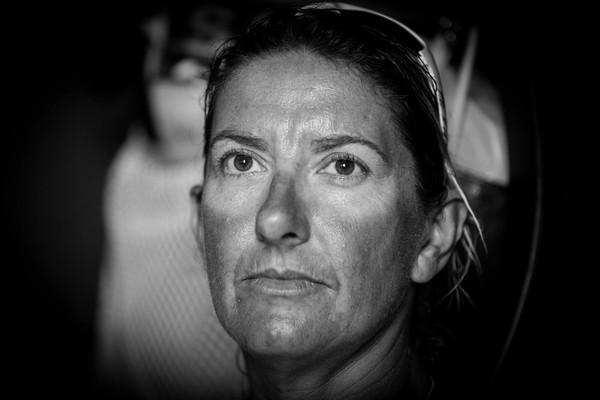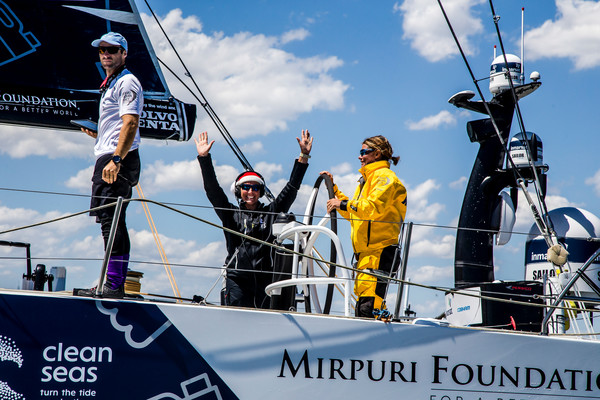Dee Caffari — career sailor and educator — on sports and sustainability, and providing sporting opportunities

Competing in the Volvo Ocean Race 2017 – 2018 as skipper of the team Turn the Tide on Plastic, Dee Caffari is a seasoned career sailor, having started sailing full-time 17 years ago after 5 years as a teacher. This race is considered one of the longest and toughest professional sporting events in the world, where teams compete 45,000 nautical miles across four oceans, six continents and twelve cities. This year Hong Kong is one of the host cities and it’s the first time the city has hosted this sporting event.
By the time teams reach Hong Kong, they would have spent approximately 66 days already sailing from Alicante to Lisbon to Cape Town to Melbourne and then to Hong Kong. There’ll be another 78 days or so of competition, excluding the stops at each city. All in all, teams compete for around eight months.
In 2006, Dee became the first women to sail solo and non-stop around the world. She did this again in 2009, going in the opposite direction, and thus becoming the first woman in the world to sail solo around the world twice, in both directions.
During her stop in Hong Kong as part of the race, we caught up in person with Dee at the Volvo Ocean Race Village out at Kai Tak. The venue is open till 31 January and fun to wander around to visit the various exhibitions that promote education, sustainability and ocean health. You can even see what it’s like to be on a sailing boat!
(This interview has been edited and condensed for length).
How did you decide to pursue a sailing career?
When I was a teacher, I loved my job. But it was the right job too soon. I still wanted to travel and have adventure. I decided to change careers after five years of teaching, much to my mother’s dismay. I’ve never looked back and I’ve managed to make a career out of sailing.
I try to keep myself busy sailing as much as possible. Now I also have the opportunity to do quite unique things, such as speaking at dinners and conferences. That helps with the income.

Leg 4, Melbourne to Hong Kong, start. Photo by Beau Outteridge/Turn the Tide on Plastic. 02 January, 2018.
In 2006 you sailed solo around the world and you were the first woman to do this. And you did this again in 2009. Can you share a little bit about this experience? What is it like to be out there in the middle of the sea alone, day-in-day-out for such a long period of time?
The first solo trip I did is what is usually considered the “wrong way round the world,” so going against prevailing winds and currents. That trip took six months. I’d never even lived on my own or sailed alone before that trip, so it was a bit of an exploration and it’s pretty difficult to spend 24 hours a day by yourself.
I realized why only five people had ever done that, and that’s because everyone else goes the other way around the world. So I decided that I wanted to go the “right way round the world,” and the next time I went, I did, which took less than half the time my first trip. It was much easier, because I had learned how to live by myself and spend time alone. I did the wrong way round without much preparation. So when I did the right way round it was more of a competition and I prepared a bit more, especially psychologically. I worked with a sports psychologist and learnt how to better manage myself.
Instead of having this emotional roller coaster [from the first trip], I was much more level and could focus on the right things, and that made me a much stronger person.
Was this emotional roller coaster the most challenging aspect about being alone?
With sailing you can learn to sail on your own, that’s fine. But to spend six months alone without external interaction is quite hard work. I would have extreme highs of “this is fantastic” and then be crying but not really understand why. You’re tired, you get very emotional and little things can affect you. It’s exhausting.
So then when I did the psychological preparation the second time, I learned how to react. A lot of it is just need eat and sleep; if you eat a meal and have a small sleep, you put yourself in a much better position to make more level decisions. Being on the water is all about being able to make decisions. You look at the weather and decide what to do next. It becomes easier to manage.

Leg 4, Melbourne to Hong Kong, Day 12 onboard Turn the Tide on Plastic. A candid moment where I caught Dee Caffari staring out the hatch. What is she thinking? Photo by Brian Carlin/Volvo Ocean Race. 13 January, 2018.
How did you deal with this emotional roller coaster, especially the lows?
There were many people helping me to get to the finish line. When people commit time and effort, you want to “reward” them or don’t want to let them down, so I was always going to make sure that I finished. It simply is that some days are harder than others, but I’m very resilient, as in I don’t give up easily and I’m very stubborn, as in I will see something through. You need that element of being a little bit selfish and a little bit of stubbornness to make sure you stay on track.
The steepest learning curve is learning about yourself. I think sometimes people fear going on a big adventure because they are fearful to learn about themselves.
What did you learn about yourself in this process?
I learned how I react when I am tired or hungry. Also, what things are important to me. I’m driven by feedback so when you’re on your own, you don’t receive any external inputs so you have to drive that yourself. Then you start to understand why you react to different things and why you develop different ways when you’re in different situations. Once you understand how you react to things you can better manage yourself.
Did this trip enhance your resiliency?
You realize what the extremes are and everything then becomes relative. So if you go through a bad storm, yes, you deal with it and afterwards you think, “oh that was really scary,” but then when the next one comes you think, “well this wasn’t as bad as last time.” So you grow in your resilience.
Is there anything from that trip that you apply on a day-to-day basis?
I’m very methodological and I have learned to focus. I have learned not to waste my energy looking at things that I can’t do anything about. For example you can get frustrated because you want something to happen, but if you can’t make the change, then don’t waste your energy worrying about it; move onto something that you can control. Because I am much more like this now, I am more conscious about where I expend my energy.
Moving on to the Volvo Ocean Race and being the skipper for the team, Turn the Tide on Plastic your team competes while promoting ocean health. Why is sustainability important to you? Why have you agreed to be the skipper for this team?
Ocean health is extremely close to my heart. This is my sixth time around the world and each time the affect of pollution gets progressively worse. You see more debris and plastic in the ocean and the impact gets larger. The ocean is our playground, our office where we go to work in. We feel a responsibility to look after it, but it’s about pushing a message out that there it is everybody’s responsibility. Our actions together have an impact. Timing wise, it was perfect for me to have a project that could promote the messages that we’re giving.
What do you hope to achieve through your campaigns and by competing as Turn the Tide on Plastic?
The race visits twelve host cities around the world and has a massive audience. We’re trying to make people change their relationship and behaviours with single-use plastic. The problem in the world is massive and too big to deal with, but if we look at it individually and think, “what small change can I make?” then collectively we can make an impact. It’s about not buying plastic bottles and using a water bottle that you can refill, or not having a straw in your drink because it’s the straw that is an issue, or not using plastic bags but taking a reusable bag. Those are just three examples but they are simple. If we all start to change our behaviour, together we will make change.
This change will force manufacturers and suppliers and therefore government legislation to change and hopefully we will have an even larger impact.
Hong Kong is not the most sustainable city in the world. For example, there’s plastic everywhere. As someone who’s come to Hong Kong for the first time, what is your impression of the sustainability issues that Hong Kong is facing?
Obviously we go to a number of places and many places are at a different level in terms of making the effort to implement change. I’ll say that Asia probably has the biggest journey to go, but there are signs of it starting. Having recycling bins is a start for example. However, the culture is more challenging because it’s quite a disposable culture. You see schoolchildren with plastic drinks with straws in, walking along. Say in the U.K. for example, it’s the children who are saying no to plastic to their moms and dads. The education needs to start at the school age route to make change for Hong Kong.

Leg 03, Cape Town to Melbourne. Arrival in Melbourne. Photo by Jesus Renedo/Volvo Ocean Race. 26 December, 2017.
There are many sporting events now that are advocating messages of sustainability. Sports and sustainability have become a much more integrated message. What do you see are the linkages between sports and sustainability? Why do you think sports are a good way to raise awareness for sustainability.
There are statistics, for example in the US, that there are so many more people who engage in sport then they do news or documentaries. So if you have an audience that is much bigger anyway, and you can link a message through to that audience, you’ll reach so many more people. I think that generally, people who also follow sports also follow trends. So if that sport is saying, “we don’t want to do this and believe in that instead,” then those fans will also adopt that message as well. I think the message around sustainability is much more powerful to sports fans.
Turn the Tide on Plastic is 50-50 male to female and your team comprises mostly of sailors younger than 30 years old. Why is this important to you?
I was a very strong advocate for the mixed-team rule in this race* because I think that is the way forward. Luckily for me that is how I have mostly done my sailing. Still, in this day and age, it is quite old-fashioned to think sailing is a boys’ club, but sadly this sport – and many others – is still a boys’ club. I was quite keen to make the change and Volvo wanted me to make the biggest change, so they asked if I could go 50-50. I promised that my team would be 5 men, 5 women. It’s an environment that I am really enjoying working in, and seeing the sailors develop.
The other idea was to provide a platform of opportunity. I think when you’re giving a message about sustainability, the younger sailors are genuinely more passionate about it. They believe it is their responsibility to do something about it so it is a much more clear message. It is nice to have who maybe who don’t have the experience, but who have the skill and they think differently. They say, “let’s try this” and “let’s try that”. For me, being a former teacher, to have the ability to empower people with this opportunity is perfect. I have loved seeing them grow, leg by leg.
Why do you think sailing is still perceived as a boys’ club?
In the same way that many teams have the same people back time and time again, and would not dream of what I have done with a new team of young people, it’s because you get comfortable with who you sail with. You get comfortable with those you trust and know, and guys are big and strong, and reassuring. It’s pushing them out of their comfort zone to do something different. I think it’s just the easy option.
Slowly now, with every team having a female sailor, the change will slowly happen. The proof will be in future editions of the race whether there will still be mixed teams in this sport.
The Olympics now has a balance of same number of men and women in the sailing boat. The Volvo Ocean Race is the pinnacle offshore event. They wanted to show the move not to enforce mixed gender but to incentivize it so that people could make the choice, but it would benefit if they did. So all the teams now are mixed.
What do you think have been some of the barriers that have prevented women from trying sailing in the first place?
Normally it’s that people don’t know how to access the water. Once people know where and how, then they realize sailing is very accessible and open to everyone. But it’s that initial, “where do I go to try it?” that is a barrier. This is what we as a sport always get wrong.
Sometimes women are afraid of big solo challenges, and being away from home for long periods of time. What would you say to women about going on these long sailing trips and adventures that could maybe inspire them to try it once?
The opportunity to be out on the water is liberating. Sailing is about harnessing nature and you get to see wildlife in their own habitat, to see sunrises, sunsets and night skies with no ambient light. It’s very unique. Genuinely, sailing is an environment that is considered “male,” so it puts women and girls off from even trying it. But once they have tried it, then they realize that it’s just a preconception. There are many different roles that are important to make a boat sail; there are those that are more physical and those that are more cerebral. There is a role for everyone and that is the secret of a good experience – getting the right people in the right roles.
It’s similar to being in a boardroom. There are men and women and everybody has a role in making a team a high performance team, and you play to your strengths.
I would like to move the sport from having male or female and simply have sailors. If you’re better at one job then you do it, and if I’m better at something else then I’ll do that.
*Note: There is a new rule within Volvo Ocean Race that incentivises mixed teams. So for example if the team is comprised only of men, they have seven people only. If you have women, you can have more team members. So for example you can have seven men with one or two women, or five men and five women, or seven women and one or two men, or eleven women.
